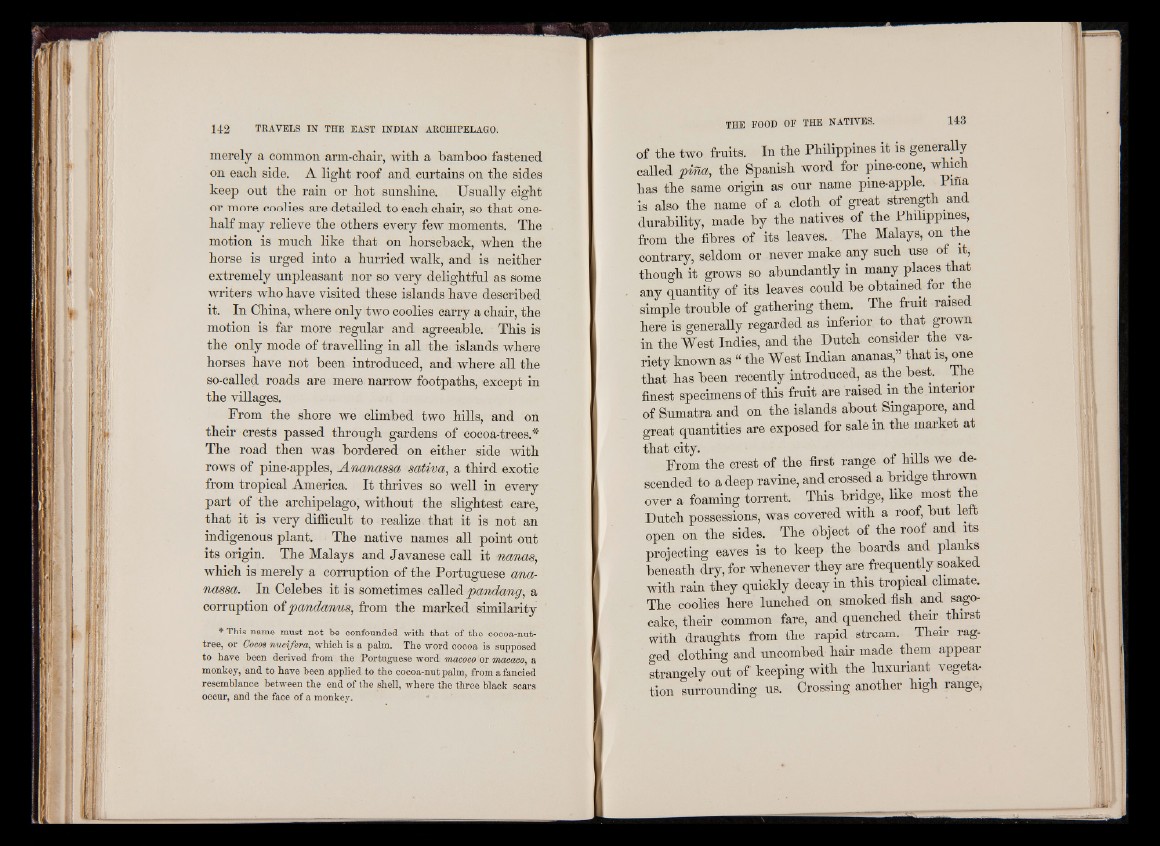
merely a common arm-chair, with a bamboo fastened
on each side. A light roof and curtains on the sides
keep out the rain or hot sunshine. Usually eight
or more coolies are detailed to each chair, so that one-
half may relieve the others every few moments. The
motion is much like that on horseback, when the
horse is urged into a hurried walk, and is neither
extremely unpleasant nor so very delightful as some
writers who have visited these islands have described
it. In China, where only two coolies carry a chair, the
motion is far more regular and agreeable. This is
the only mode of travelling in all the islands where
horses have not been introduced, and where all the
so-called roads are mere narrow footpaths, except in
the villages.
From the shore we climbed two hills, and on
their crests passed through gardens of cocoa-trees.*
The road then was bordered on either side with
rows of pine-apples, Ancmassa sativa, a third exotic
from tropical America. It thrives so well in every
part of the archipelago, without the slightest care,
that it is very difficult to realize that it is not an
indigenous plant. The native names all point out
its origin. The Malays and Javanese call it ncmas,
which is merely a corruption of the Portuguese oma-
nassa. In Celebes it is sometimes called pcmda/ng, a
corruption of pandanus, from the marked similarity
* This name must not be confounded with that of the cocoa-nut-
tree, or Cocos nucifera, which is a palm. The word cocoa is supposed
to have been derived from the Portuguese word macoco or macaco, a
monkey, and to have been applied to the cocoa-nut palm, from a fancied
resemblance between the end of the shell, where the three black scars
occur, and the face of a monkey.
of the two fruits. In the Philippines it is generally
called pina, the Spanish word for pine-cone, which
has the same origin as our name pine-apple. ma
is also the name of a cloth of great strength and
durability, made by the natives of the Philippines,
from the fibres of its leaves.. The Malays, on the
contrary, seldom or never make any such use of it,
though it grows so abundantly in many places that
any quantity of its leaves could be obtained for the
simple trouble of gathering them._ The fruit raised
here is generally regarded as inferior to that grown
in the West Indies, and the Dutch consider the va-
riety known as “ the West Indian ananas,” that is, one
that has been recently introduced, as the best. The
finest specimens of this fruit are raised in the interior
of Sumatra and on the islands about Singapore, and
great quantities are exposed for sale in the market at
that city.
From the crest of the first range of hills we descended
to a deep ravine, and crossed a bridge thrown
over a foaming torrent. This bridge, like most the
Dutch possessions, was covered with a roof, but left
open on the sides. The object of the roof and its
projecting eaves is to keep the boards and planks
beneath dry, for whenever they are frequently soaked
with rain they quickly decay in this tropical climate.
The coolies here lunched on smoked fish and sago-
cake, their common fare, and quenched their thirst
with draughts from the rapid stream. Their ragged
clothing and uncombed hair made them appear
strangely out of keeping with the luxuriant vegetation
surrounding us. Crossing another high range,